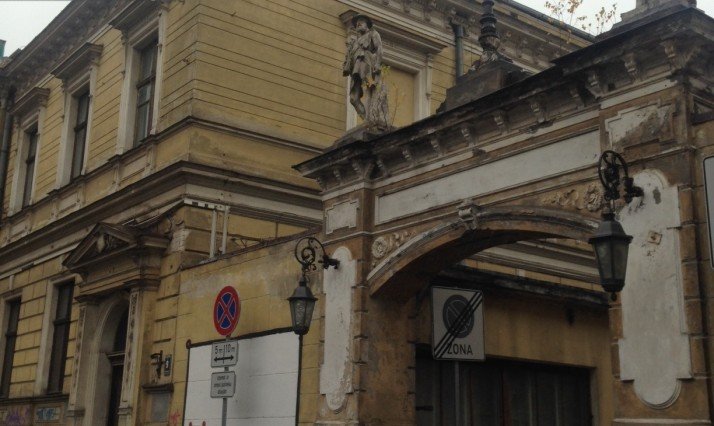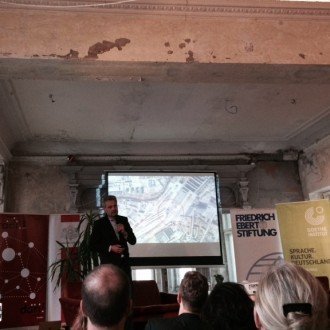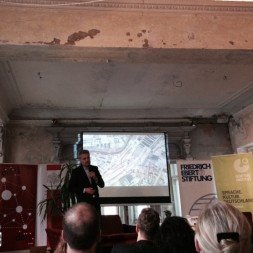Conference and workshop on “empty spaces” in Riga




Empty spaces
On the 12th and 13th of October the Empty Spaces conference and workshop, was held in the “hipster” neighbourhood around Miera Iela in Riga. This was part of the “radi!” week in the Latvian capital, where people can experience various creative projects in the city. The conference concerned what to do with the many abandoned buildings in Riga, and the venue illustrated this problem perfectly. It was held in the beautiful but worn-down Fon Stricka Villa. A building that has been used for a number of things ranging from brewery to Romanian embassy, but has been empty for fifteen years, which has left its mark on the building.
Since the restoration of independence Rīgas population has shrunk by 25%, which has resulted in many abandoned buildings around the city. These building have been allowed to decay over the years, as lack of use combined with Baltic winters, have set their mark on them. This sparked the 2012 movement “free Riga” a group of young people who wants to repurpose the empty buildings into creative industries and cultural venues. The movement sparked the notion that something had be done about all these buildings. This meant that the ministry of culture, the municipality in Riga and various institutions such as the art academy. One of the first, and best, ideas was to create office spaces for, mainly young, people to set up small creative business. So far 15 such offices spaces have been made available around Riga, creating space for one or two-person creative businesses. However the problem of abandoned buildings is still there. That is why this conference was organized. On the first day experts from Denmark, Estonia, France, Germany, and Latvia spoke to the creative class of Riga, on how this problem had been dealt with in other European countries. On the second day a Workshop had been organized, where the Latvian creative minds could meet experts on this subject.
International empty spaces, the conference
“Empty space is a physical illusion as the veil between empty space and filled space is the usage of it” Andreas Kruger
The municipal architect Gvido Princis started the conference by explaining the history and situation of Riga. He also touched down on the future possibilities, and explained that small scale local renovation is the best way to go, as this is more sustainable, and makes it easier to involve the public. The idea of renovating in close cooperation with the local population is an important aspect, as it creates a sense of involvement among the locals and creates closer ties between the people and the municipalityt. Gvido was followed by Lilita Sparane from the ministry of culture, who gave an introduction to various creative industries. The industries are growing in the country and helps put Latvia on the map internationally
After this introduction the international lectures gave presentations on the projects from their countries. The speakers were
- Andreas Kruger chairman of the Belius foundation from Berlin in Germany, who spoke about what matters when reusing space and creating creative industries.
- Michael Troelsen from the municipality of Aarhus in Denmark, who spoke about the importance of people working together with the municipality.
- Camille Vilain from the art school in Saint-Etienne in France, who presented how Saint-Etienne has renovated and old weapons factory into a creative space for all people around the city.
- Hans-Gerd Nottenboom managing director of Union-Geweberhof fur umwelt- und sozialverstragliche Techniken GmbH from Dortmund in Germany, who spoke about cooperative ownership and management when dealing with a creative space.
All the speakers pointed to cooperation between citizens, creative industries, the municipality and property owners as one of the most important aspects of using the buldings. This cooperation creates the foundation of filling the empty spaces, and the first thing is to convince investors and people that repurposing is a good investment. In Aarhus the creative site “institute X” has an annual turnover of 3 million Euro. In Berlin the many smaller creative business managed to make money during the recession. These examples can be used to convince the owners of the buildings, that repurposing empty space as creative work space is a sound investment. The lectures also contributed a number of concrete ideas on how to use the vacant buildings, which varied from art galleries to public schools, and how to get into the mindset of creating from empty space. The lectures left the participants inspired and ready for the challenge.
After the conference we were taken on a tour around some of the abandoned buildings of Riga, that the municipality and art academy had plans for. Seeing how these old beautiful buildings can once again come to life is a truly magnificent prospect. When walking through these buildings in Riga the potential of the city became apparent all the participants, and an almost childlike excitement gripped people when they started to talk about what to do with these spaces. So the first day ended in high spirits.
Improving Riga, the workshop
The day afterwards the workshops were kicked off by Martin Melioranski, the director of 3DL Estonian Academy of Arts Faculty of Architecture Tallinn, Estonia. He spoke about how institutions such as the art academy can also use abandoned buildings, and how students can be a vital part in the process of reusing space. After Martins lecture representatives from six case studies around Latvia. These inspirational young people had all created spaces for creative industries around the country. They are evidence of a movement in Latvia of creative business, and energized young people who will fight for the reuse of space.
This was followed by four roundtable discussions that each dealt with different questions that Riga has regarding promoting itself as a creative city. Each group was led by one of the lectures, and consisted of the creative minds of Latvia. The young creatives took to this opportunity with great vigor, and they had many interesting observations and ideas on how to revitalize the buildings of Riga. The workshop ended with a number of ideas being carried forward, where the most important one was closer cooperation with the municipality. This cooperation could prove to be very fruitful and in the future, we will see much more usage of empty buildings in Riga, and a stronger and more visible creative environment, all thanks to great arrangements like this.